Performance Analysis of Variable Mode Adsorption Chiller at Different Recooling Water Temperatures
Abstract
:1. Introduction
2. System Description
3. Materials and Methods
3.1. Adsorbent Material Characterization
3.2. Experimental Determination of Adsorption Isotherms and Adsorption Kinetics
3.2.1. Adsorption Isotherms
3.2.2. Rate of Adsorption
- : instantaneous water uptake (kg·kg−1);
- maximum water uptake (kg·kg−1);
- R: ideal gas constant (J·mol−1·K−1);
- T: adsorption temperature (K);
- Rp: radius of the adsorbent granules (µm);
- Dso: pre-exponential constant of surface diffusivity (m2·s−1);
- Ea: activation energy of diffusion (J·mol−1).
3.3. Adsorption Cooling System Model
- The temperature, pressure, and adsorption rates were assumed uniform in the adsorption beds, evaporator, and condenser.
- The water vapor flow from an adsorption bed to the condenser or from the evaporator to an adsorption bed was unrestricted, and the pressure drop was neglected.
- The chiller was well insulated, and there was no heat exchange with the exterior environment.
- The inlet temperatures for hot, recooling, and chilled water were assumed constant.
3.3.1. Energy Balance Equation for the Adsorption Bed
- : mass of zeolite in the adsorbent bed (kg);
- : specific heat capacity of zeolite (kJ/kg·K);
- : mass of the adsorbent bed heat exchanger (kg);
- : specific heat capacity of the adsorbent bed heat exchanger (kJ/kg·K);
- : specific heat capacity of water vapor (kJ/kg·K);
- : amount of water in the bed (kg);
- : heat of adsorption (kJ/kg);
- : adsorbent bed temperature (K);
- : water vapor temperature (K);
- : evaporator temperature (K);
- : recooling water mass flow rate (kg·s);
- : recooling water specific heat capacity (kJ/kg·K);
- : recooling water inlet temperature (K);
- : adsorbent bed recooling water outlet temperature (K).
- : the overall coefficient of heat-transfer (kW/m2·K) for the adsorbent bed;
- : the area (m2) of the adsorbent bed.
3.3.2. Energy Balance Equation for the Desorption Bed
- : the mass flow rate (kg/s);
- : the specific heat capacity (kJ/kg·K);
- : the inlet temperature (K);
- : the outlet temperature (K).
- : the overall coefficient of heat-transfer (kW/m2·K) of the desorber;
- : the area (m2) of the desorber.
3.3.3. Energy Balance Equation for the Condenser
- : mass of water inside the condenser (kg);
- : mass of the condensing heat exchanger (kg);
- : specific heat capacity of the condensing heat exchanger (kJ/kg·K);
- : latent heat of evaporation (J/kg);
- : recooling water mass flow rate (kg/s);
- : condenser temperature (K);
- : adsorbent bed recooling water outlet temperature (K).
- : the condenser temperature (K);
- : the overall coefficient of heat-transfer (kW/m2·K);
- : the condenser area (m2).
3.3.4. Energy Balance Equation for the Evaporator
- : mass of water inside the evaporator (kg);
- : mass of the evaporator heat exchanger (kg);
- : specific heat capacity of the evaporator heat exchanger (kJ/kg·K);
- : evaporator temperature (K).
- : mass flowrate (kg/s);
- : specific heat capacity (kJ/kg·K);
- : inlet temperature (K);
- : outlet temperature (K).
- : the overall coefficient of heat-transfer (kW/m2·K);
- : the area of the evaporator (m2).
3.3.5. Mass Balance
- : the mass of water (refrigerant) entering the evaporator (kg);
- : the mass of zeolite in the bed (kg).
3.3.6. System Performance
3.4. Experimental Setup
- The inlet hot water temperature (Th_in) of 90 0.5 °C maintained by an electric water heater with a 500 L buffer tank.
- The inlet recooling water temperature (Tre_in) of 30–50 °C maintained by a dry-cooler with a 500 L buffer tank.
- The inlet chilled water temperature (Tch_in) of 18 0.5 °C maintained by an electrical heater with a 500 L buffer tank, the electrical heater is used as a cooling load in this case.
- Hot, recooling, and chilled water flow rates for were 1.2, 1.2, and 0.71 L/s, respectively.
- Three electromagnetic flow-meters (FM_h, FM_ch, and FM_re) (manufactured by ALIA Inc., Newark, DE, USA) with accuracy of ±0.4% were used to measure the hot water, chilled water and recooling water flow rate, respectively.
- Eight platinum resistance thermometers (PT100 Class A, Pico Technology) integrated with two temperature measuring data loggers (PT-104 is a four-channel logger), a resolution of 0.001 °C, and an accuracy of 0.015 °C were used to measure the inlet and outlet temperatures of the hot, chilled, and recooling water, as well as temperature of the storage tanks.
4. Results and Discussion
- First mode: single stage.
- Second mode: mass recovery with heating and cooling; the duration was 25% of the cooling cycle duration (denoted as short mass recovery mode).
- Third mode: mass recovery with heating and cooling; the duration was 50% of the cooling cycle duration (denoted as medium mass recovery mode).
- Fourth mode: mass recovery with heating and cooling; the duration was 75% of the cooling cycle duration (denoted as long mass recovery mode).
5. Conclusions
Author Contributions
Funding
Institutional Review Board Statement
Informed Consent Statement
Data Availability Statement
Acknowledgments
Conflicts of Interest
References
- Goyal, P.; Baredar, P.; Mittal, A.; Siddiqui, A.R. Adsorption refrigeration technology—An overview of theory and its solar energy applications. Renew. Sustain. Energy Rev. 2016, 53, 1389–1410. [Google Scholar] [CrossRef]
- De Boer, J.H.; Custers, J.F.H. Adsorption by van der Waals forces and surface structure. Physica 1937, 4, 1017–1024. [Google Scholar] [CrossRef]
- Ambarita, H.; Kawai, H. Experimental study on solar-powered adsorption refrigeration cycle with activated alumina and activated carbon as adsorbent. Case Stud. Therm. Eng. 2016, 7, 36–46. [Google Scholar] [CrossRef] [Green Version]
- Núñez, T.; Mittelbach, W.; Henning, H.-M. Development of an adsorption chiller and heat pump for domestic heating and air-conditioning applications. Appl. Therm. Eng. 2007, 27, 2205–2212. [Google Scholar] [CrossRef]
- Wang, R.Z. Adsorption refrigeration research in Shanghai Jiao Tong University. Renew. Sustain. Energy Rev. 2001, 5, 1–37. [Google Scholar] [CrossRef]
- Restuccia, G.; Freni, A.; Vasta, S.; Aristov, Y. Selective water sorbent for solid sorption chiller: Experimental results and modelling. Int. J. Refrig. 2004, 27, 284–293. [Google Scholar] [CrossRef]
- Xia, Z.Z.; Chen, C.J.; Kiplagat, J.; Wang, R.Z.; Hu, J.Q. Adsorption Equilibrium of Water on Silica Gel. J. Chem. Eng. Data 2008, 53. [Google Scholar] [CrossRef]
- Habib, K.; Saha, B.B.; Koyama, S. Study of various adsorbent-refrigerant pairs for the application of solar driven adsorption cooling in tropical climates. Appl. Therm. Eng. 2014, 72, 266–274. [Google Scholar] [CrossRef] [Green Version]
- Shi, B. Development of an MOF Based Adsorption Air Conditioning System for Automotive Application. Ph.D. Thesis, University of Birmingham, Birmingham, UK, 2015. [Google Scholar]
- Sayılgan, Ş.Ç.; Mobedi, M.; Ülkü, S. Effect of regeneration temperature on adsorption equilibria and mass diffusivity of zeolite 13x-water pair. Microporous Mesoporous Mater. 2016, 224, 9–16. [Google Scholar] [CrossRef] [Green Version]
- Elsayed, E.; Al-Dadah, R.; Mahmoud, S.; Elsayed, A.; Anderson, P.A. Aluminium fumarate and CPO-27(Ni) MOFs: Characterization and thermodynamic analysis for adsorption heat pump applications. Appl. Therm. Eng. 2016, 99, 802–812. [Google Scholar] [CrossRef]
- Chen, H.J.; Cui, Q.; Li, Q.G.; Zheng, K.; Yao, H.Q. Adsorption-desorption characteristics of water on silico-alumino-phosphate-34 molecular sieve for cooling and air conditioning. J. Renew. Sustain. Energy 2013, 5, 053129. [Google Scholar] [CrossRef]
- Sing, K.S.W. Reporting physisorption data for gas/solid systems with special reference to the determination of surface area and porosity (Recommendations 1984). Pure Appl. Chem. 1985, 57, 603–619. [Google Scholar] [CrossRef]
- Sun, B.; Chakraborty, A. Thermodynamic formalism of water uptakes on solid porous adsorbents for adsorption cooling applications. Appl. Phys. Lett. 2014, 104, 201901. [Google Scholar] [CrossRef]
- Youssef, P.G.; Mahmoud, S.M.; AL-Dadah, R.K. Performance analysis of four bed adsorption water desalination/refrigeration system, comparison of AQSOA-Z02 to silica-gel. Desalination 2015, 375, 100–107. [Google Scholar] [CrossRef]
- Wang, R.Z.; Wu, J.Y.; Xu, Y.X.; Wang, W. Performance researches and improvements on heat regenerative adsorption refrigerator and heat pump. Energy Convers. Manag. 2001, 42, 233–249. [Google Scholar] [CrossRef]
- Ghilen, N.; Gabsi, S.; Benelmir, R.; El Ganaoui, M. Performance Simulation of Two-Bed Adsorption Refrigeration Chiller with Mass Recovery. J. Fundam. Renew. Energy Appl. 2017, 7. [Google Scholar] [CrossRef]
- Al-Maaitah, A.A.S.; Al-Maaitah, A.A. Two-Stage Low Temperature Air Cooled Adsorption Cooling Unit. U.S. Patent No. 8,479,529, 9 July 2013. [Google Scholar]
- Alsarayreh, A.; Albaali, A.; Alkatib, G. Performance Analysis of Solar Air Cooling (Two-Stage Adsorption Chiller) in Jordan. In Proceedings of the 1st International Conference & Exhibition on the Applications of Information Technology in Developing Renewable Energy Processes and Systems, IT-DREPS 2013, Amman, Jordan, 29–31 May 2013. [Google Scholar]
- Al-Maaitah, A.A.; Hadi, F.M. Experimental Investigation of Two Stages Adsorption Chiller with Four Generators Utilizing Activated Carbon and Methanol as Working Pair. Int. J. Curr. Eng. Technol. 2017, 7, 43–54. [Google Scholar]
- Baiju, V.; Muraleedharan, C. Investigations on Two Stage Activated Carbon R134a Solar Assisted Adsorption Refrigeration System. In Proceedings of the Internationa Conference on Mechanical, Nanotechnology and Cryogenics Engineering, Kuala Lumpur, Malaysia, 25–26 August 2012; pp. 223–227. [Google Scholar]
- Alam, K.C.A.; Khan, M.; Uyun, A.; Hamamoto, Y.; Akisawa, A.; Kashiwagi, T. Experimental study of a low temperature heat driven re-heat two-stage adsorption chiller. Appl. Therm. Eng. 2007, 27, 1686–1692. [Google Scholar] [CrossRef]
- Wirajati, I.; Akisawa, A.; Ueda, Y.; Miyazaki, T. Experimental Investigation Of A Reheating Two-Stage Adsorption Chiller Applying Fixed Chilled Water Outlet Conditions. Heat Transf. Res. 2015, 46, 293–309. [Google Scholar] [CrossRef]
- Akahira, A.; Alam, K.C.A.; Hamamoto, Y.; Akisawa, A.; Kashiwagi, T. Experimental investigation of mass recovery adsorption refrigeration cycle. Int. J. Refrig. 2005, 28, 565–572. [Google Scholar] [CrossRef]
- Wang, K.; Vineyard, E. Vineyard. New opportunities for solar adsorption refrigeration. ASHRAE 2011, 53, 14–24. [Google Scholar]
- Chan, K.C.; Tso, C.Y.; Chao, C.Y.H. Simulation Study of the Heat and Mass Recovery on the Performance of Adsorption Cooling Systems. In Proceedings of the ASME 2014 8th International Conference on Energy Sustainability Collocated with the ASME 2014 12th International Conference on Fuel Cell Science, Engineering and Technology, Boston, MA, USA, 30 June–2 July 2014. [Google Scholar]
- Wang, R.Z. Performance improvement of adsorption cooling by heat and mass recovery operation. Int. J. Refrig. 2001, 24, 602–611. [Google Scholar] [CrossRef]
- Kabir, K.M.A.; Alam, K.C.A.; Sarker, M.M.A.; Rouf, R.A.; Saha, B.B. Effect of Mass Recovery on the Performance of Solar Adsorption Cooling System. Energy Procedia 2015, 79, 67–72. [Google Scholar] [CrossRef] [Green Version]
- Uyun, A.S.; Miyazaki, T.; Ueda, Y.; Akisawa, A. Experimental Investigation of a Three-Bed Adsorption Refrigeration Chiller Employing an Advanced Mass Recovery Cycle. Energies 2009, 2, 531–544. [Google Scholar] [CrossRef] [Green Version]
- Duong, X.Q.; Cao, N.V.; Hong, S.W.; Ahn, S.H.; Chung, J.D. Numerical Study on the Combined Heat and Mass Recovery Adsorption Cooling Cycle. Energy Technol. 2018, 6, 296–305. [Google Scholar] [CrossRef]
- Muttakin, M.; Islam, M.A.; Malik, K.S.; Pahwa, D.; Saha, B.B. Study on optimized adsorption chiller employing various heat and mass recovery schemes. Int. J. Refrig. 2021, 126, 222–237. [Google Scholar] [CrossRef]
- Al-Maaitah, A.A.; Alsarayreh, A.A.; Aldaour, M.M.; Precision Industries. Multiple Cycles Smart Adsorption chiller for High Ambient Temperatures. GCC Patent Office 48423, 12 October 2020. [Google Scholar]
- Tabata, D.; Okamoto, K.; Taniguchi, K.; Kubokawa, S.; Mitsubishi Chemical Corp. Adsorptive Member and Apparatus Using the Same. U.S. Patent 8,795,418B2, 5 August 2014. [Google Scholar]

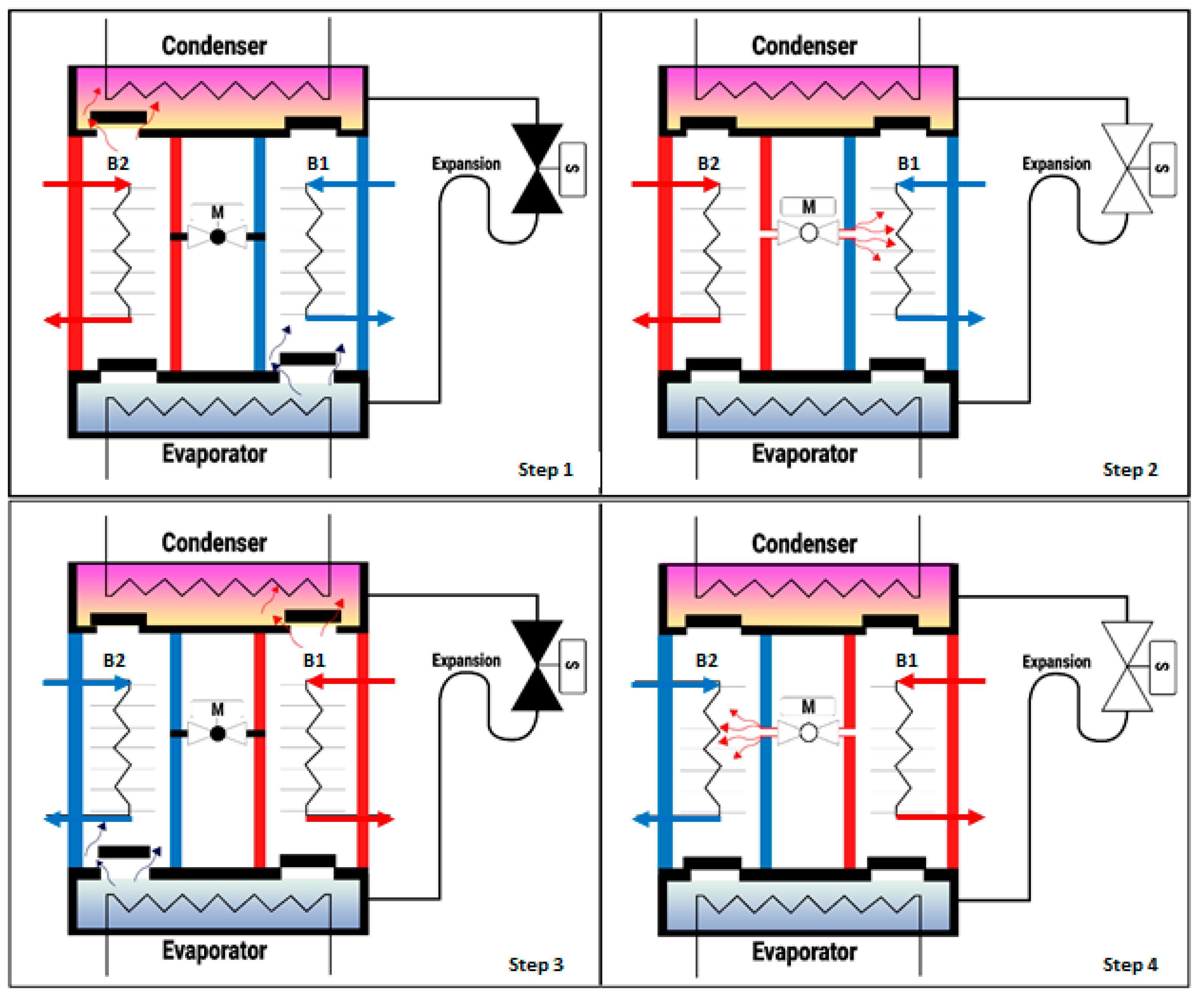

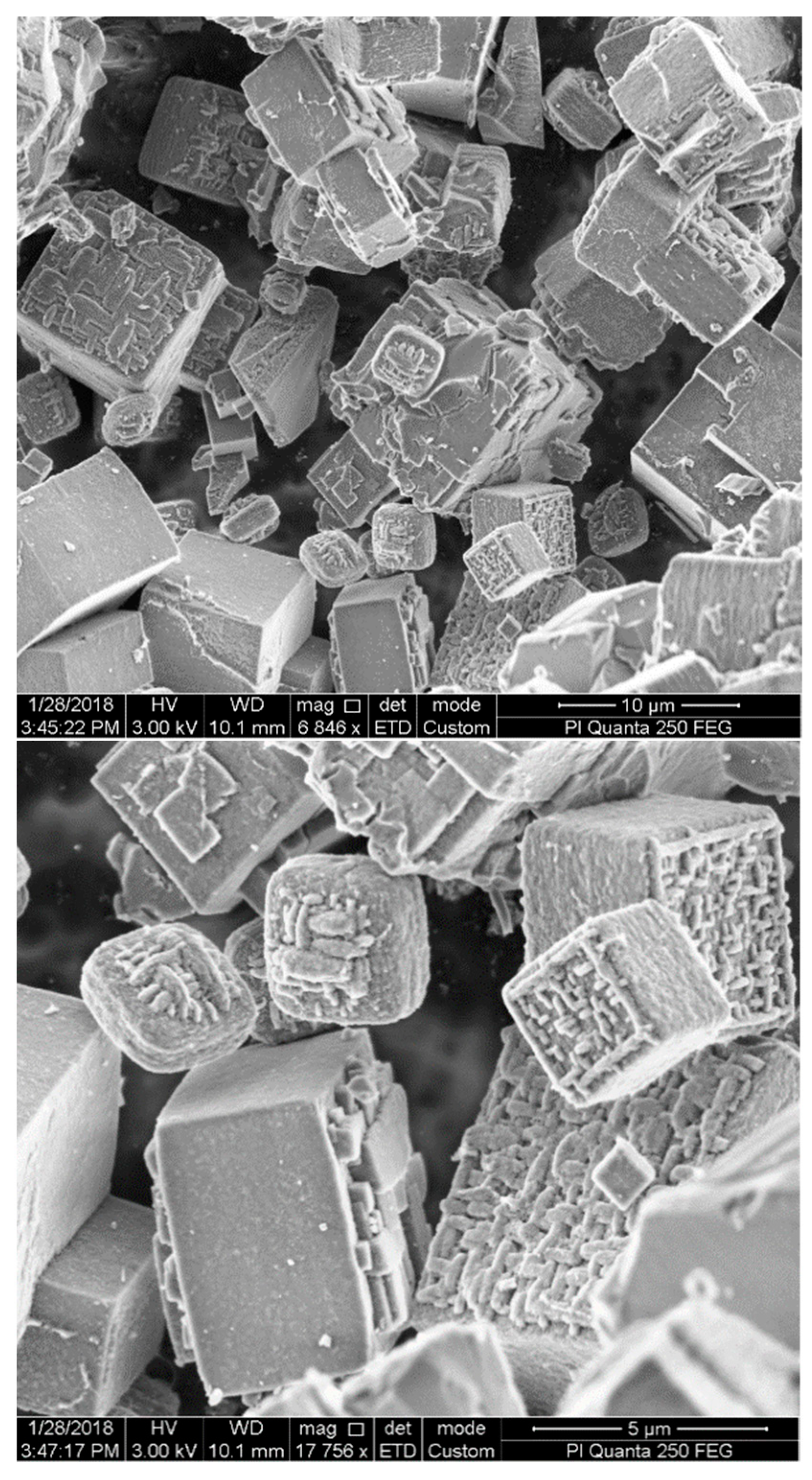

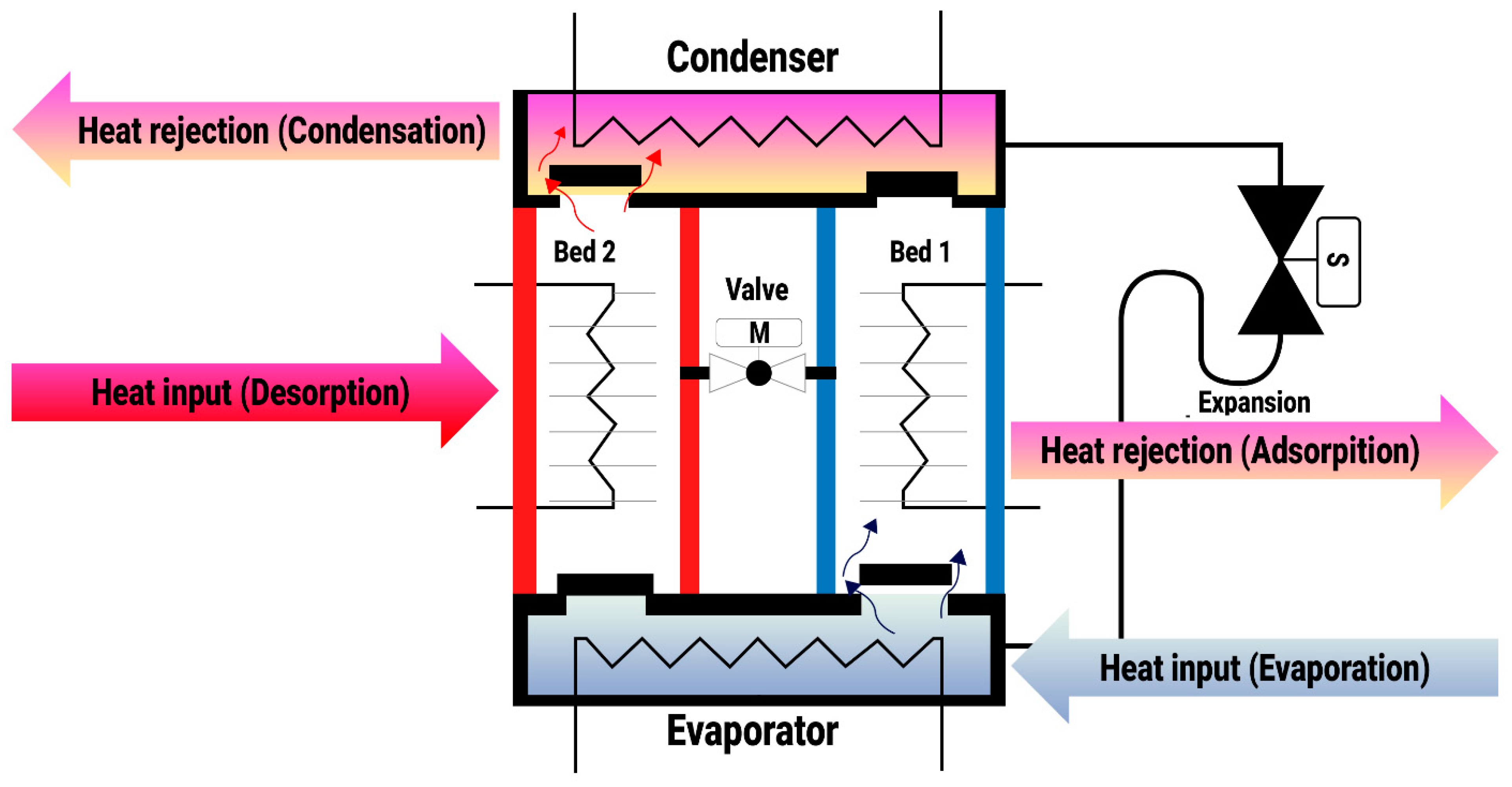
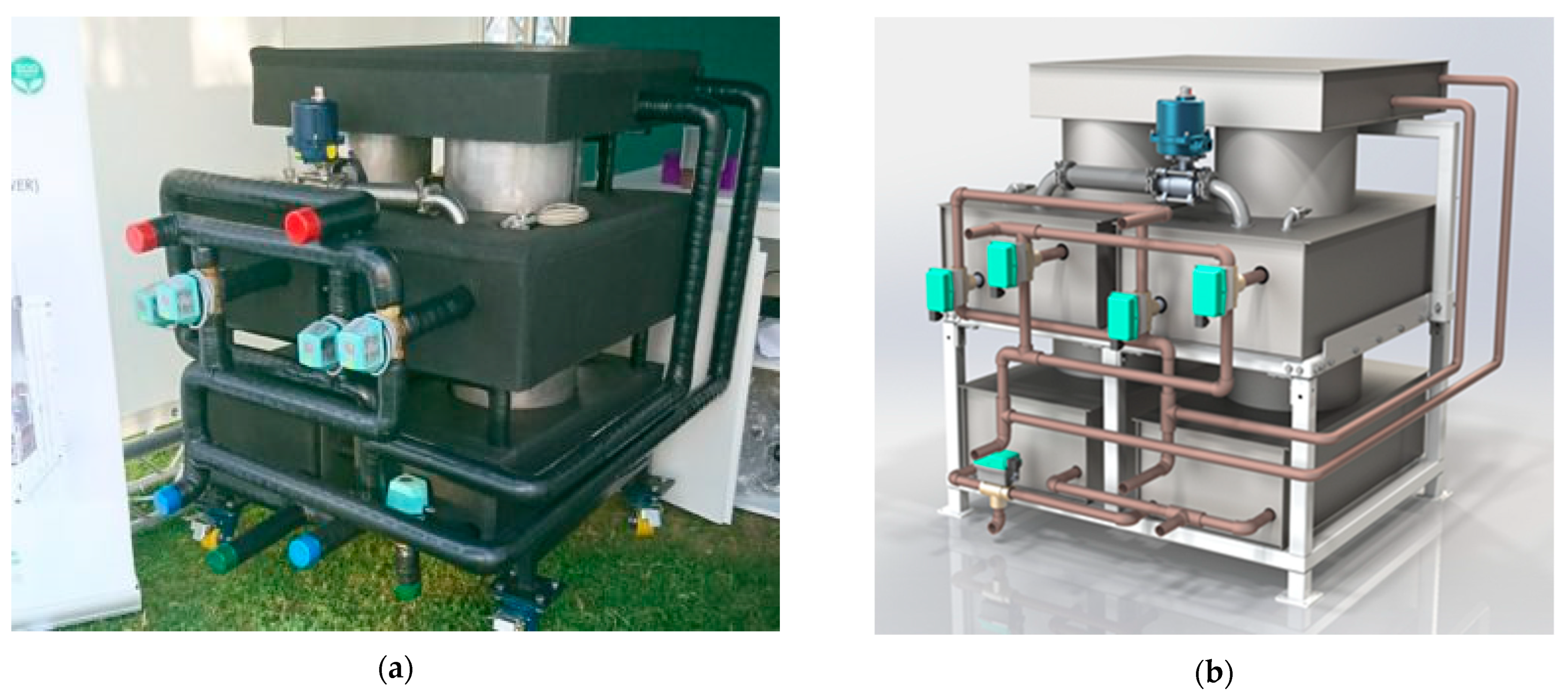
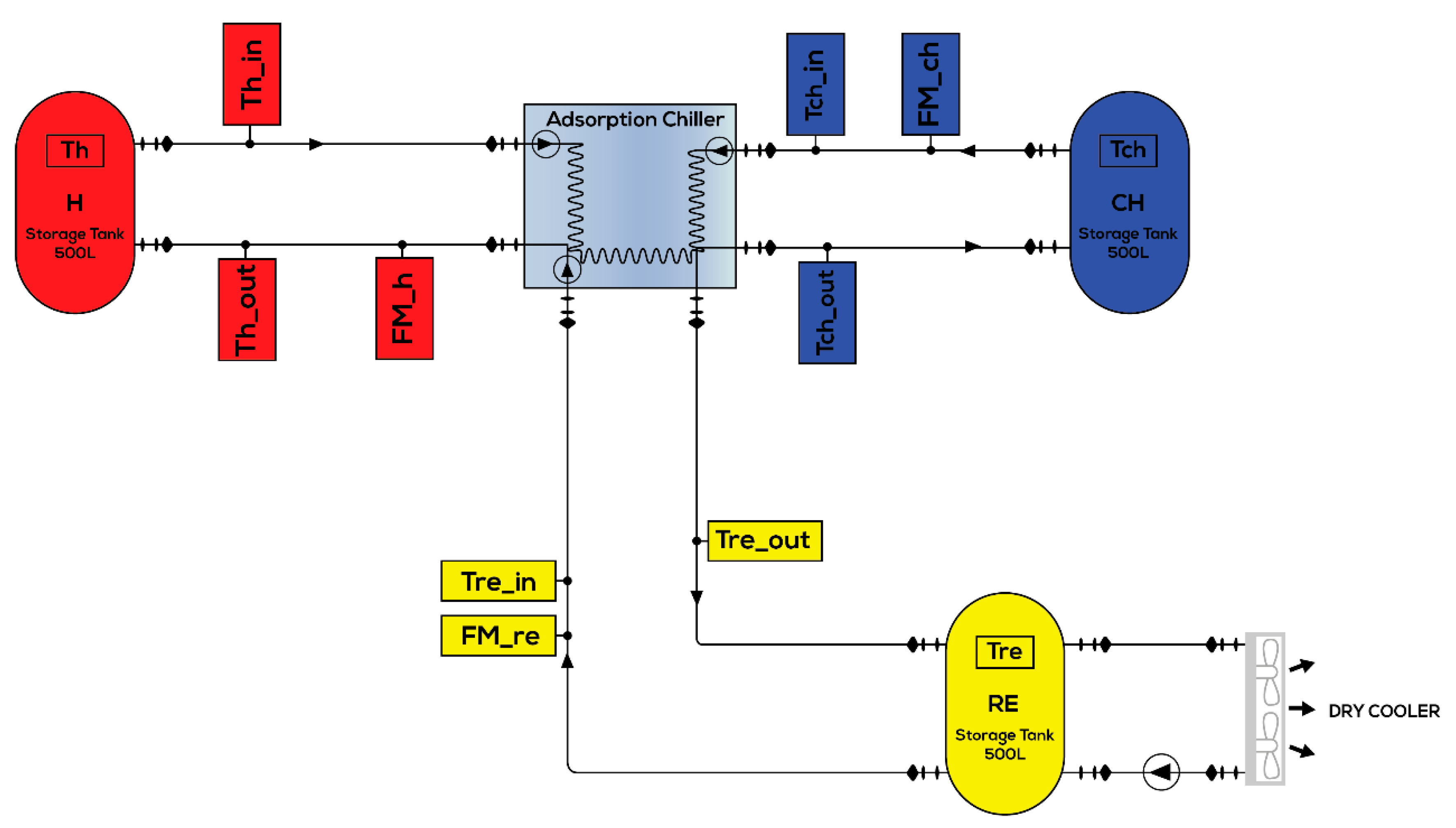
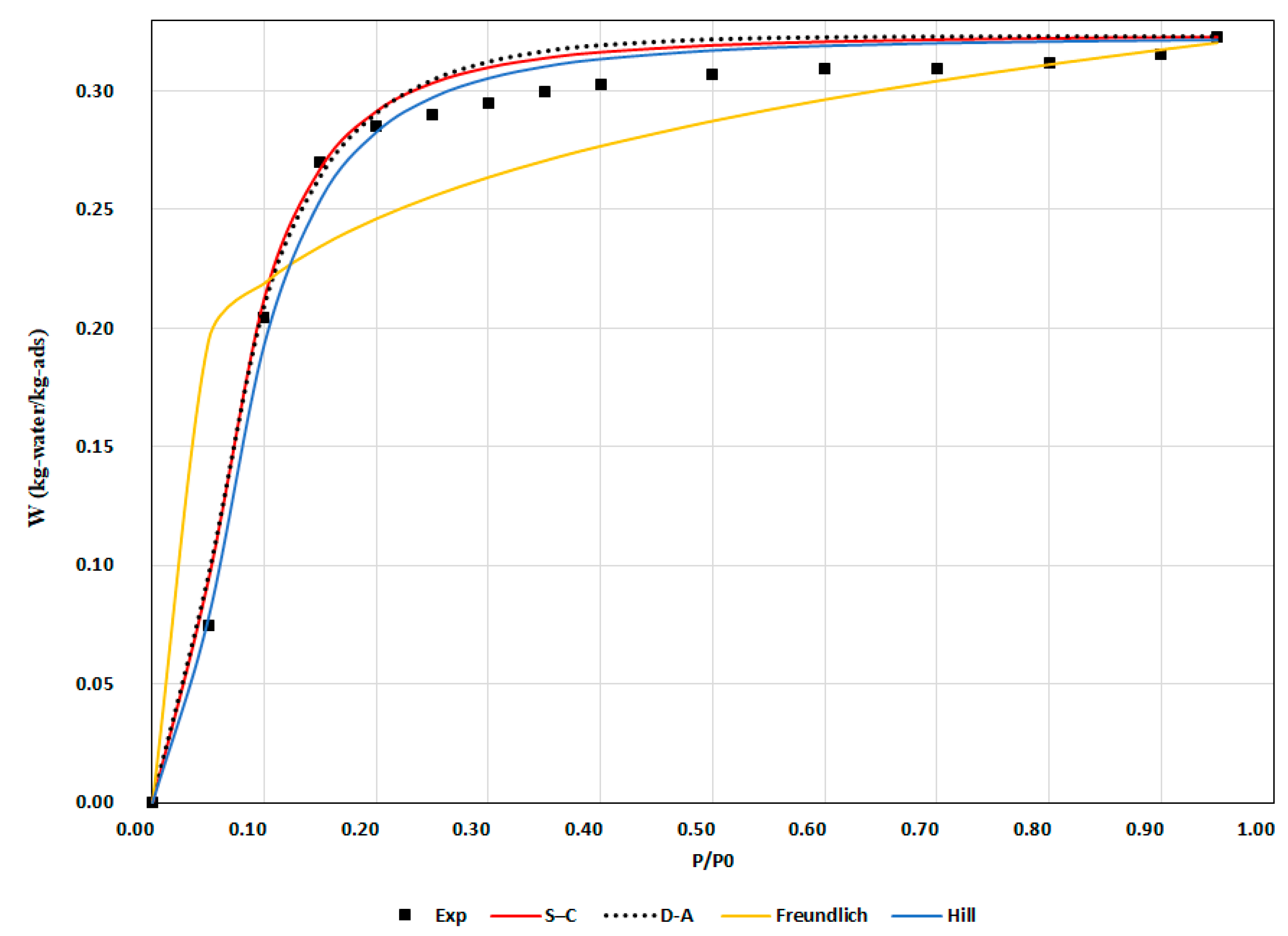
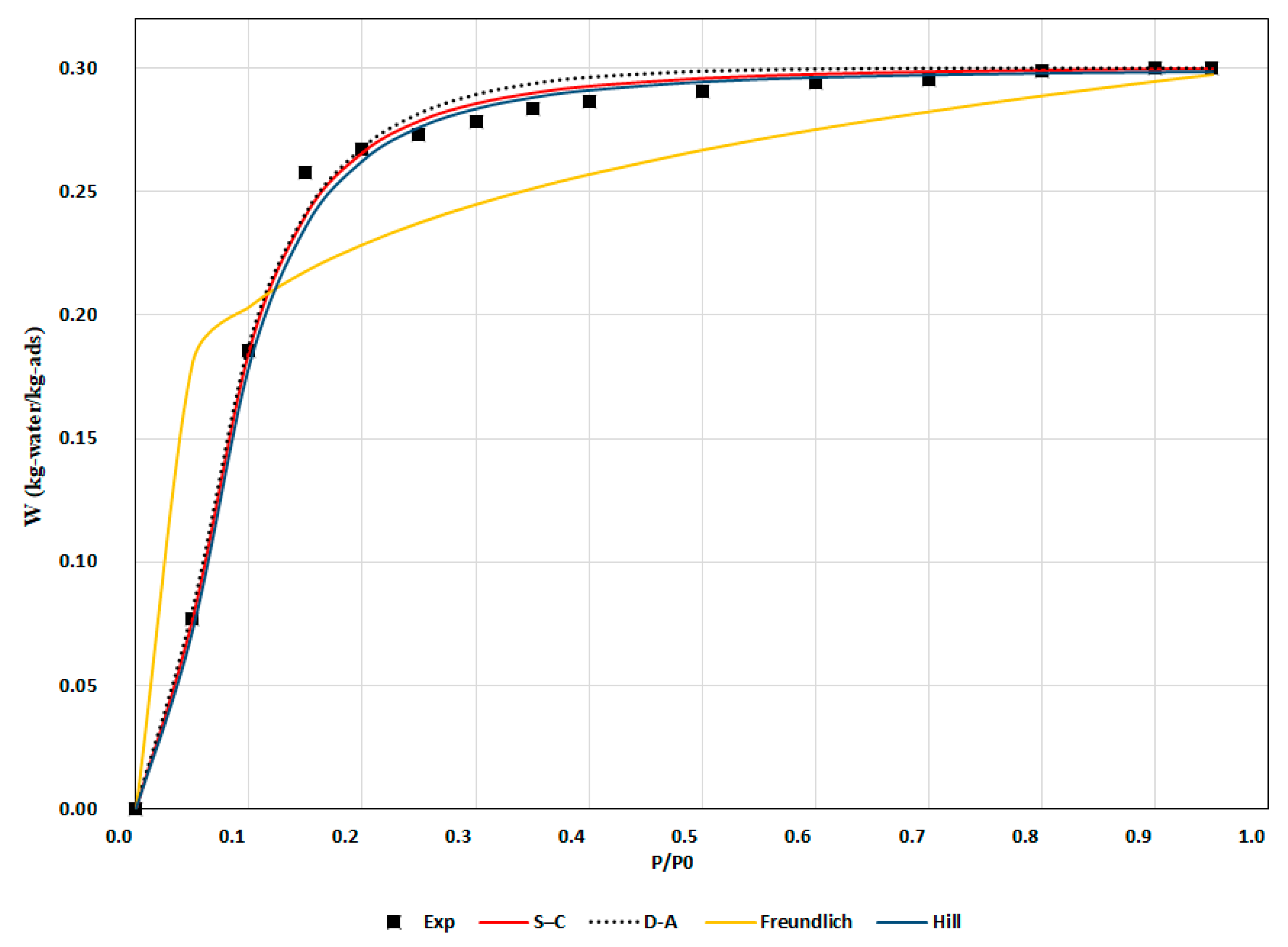

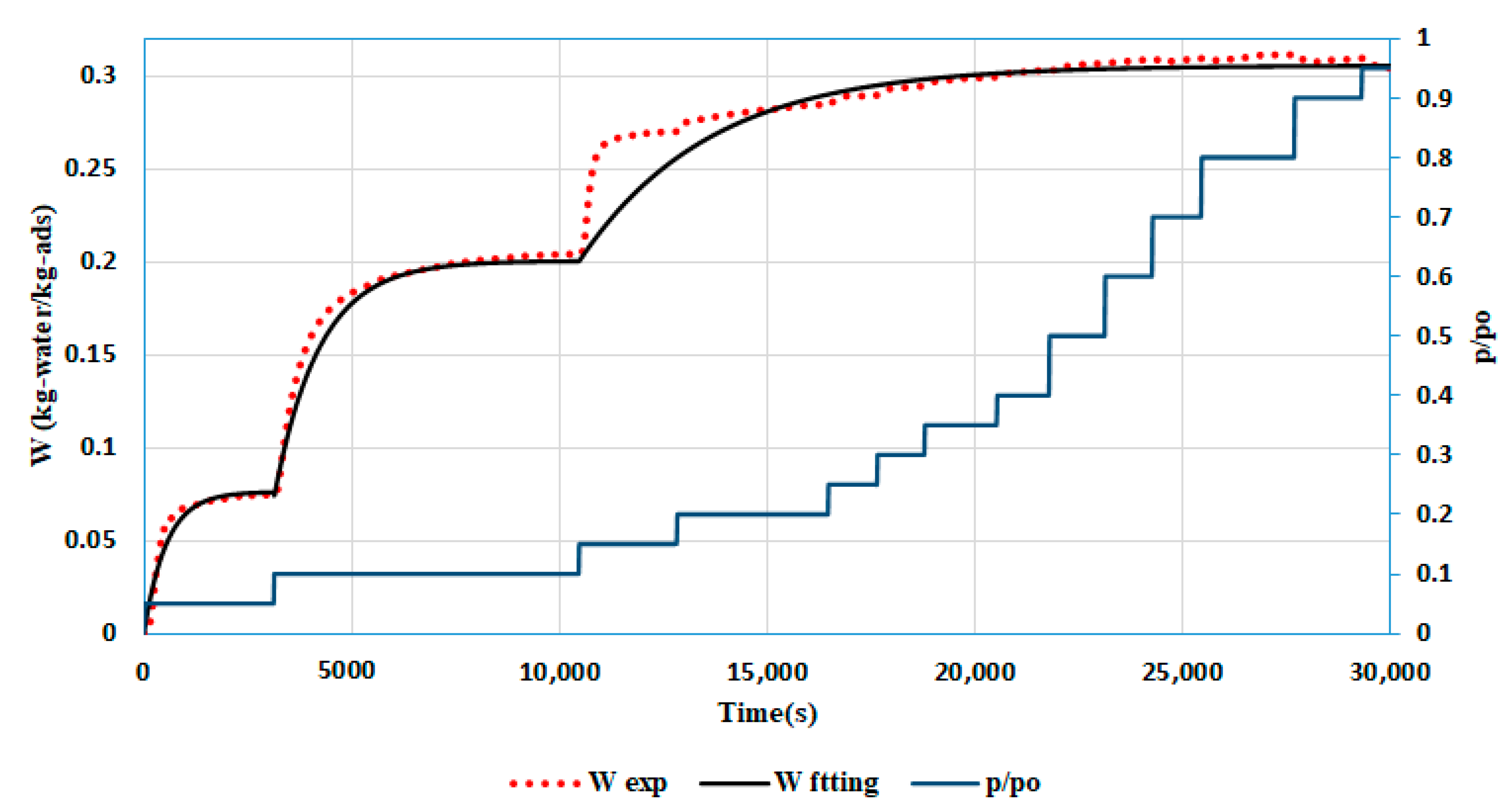


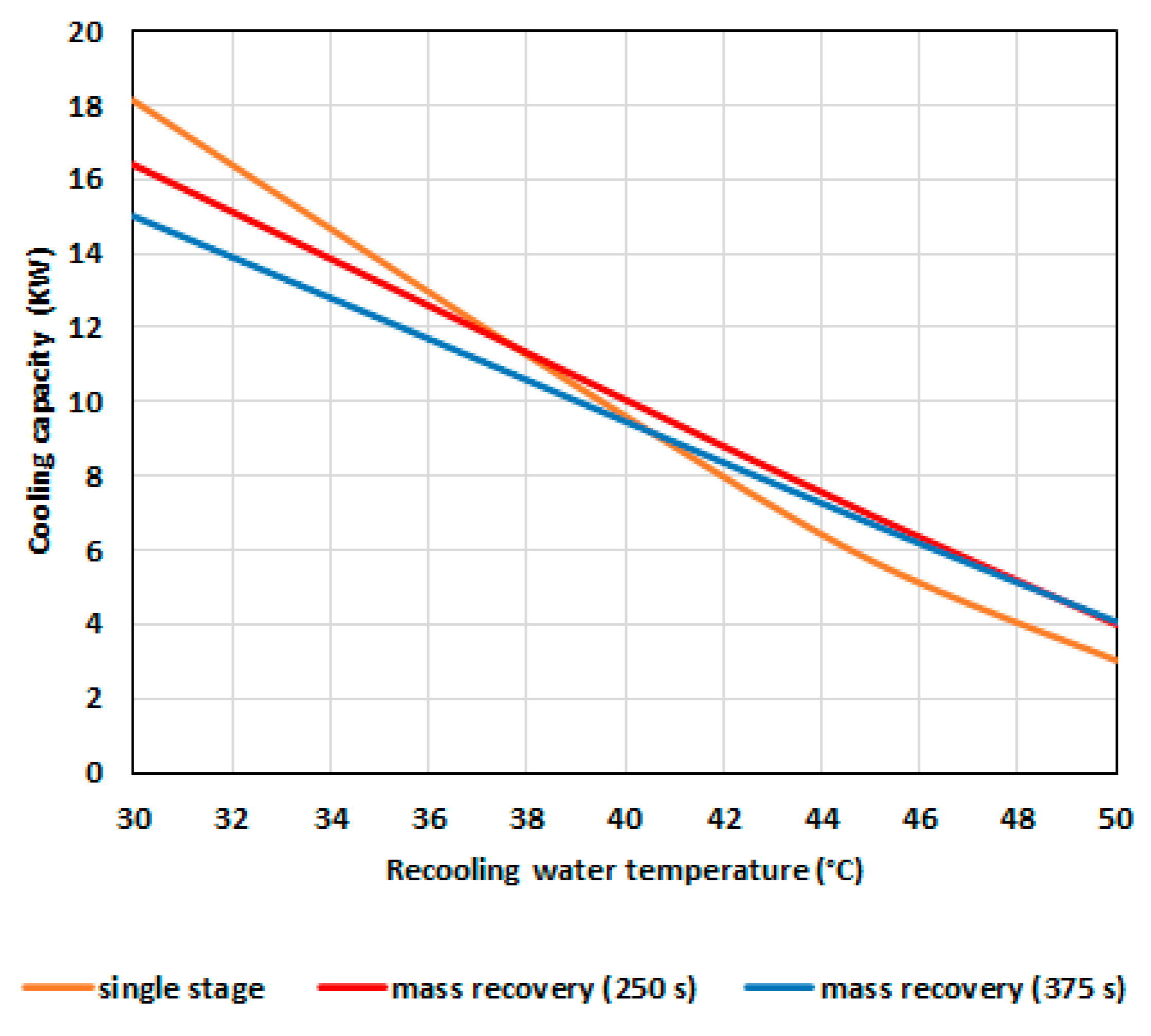

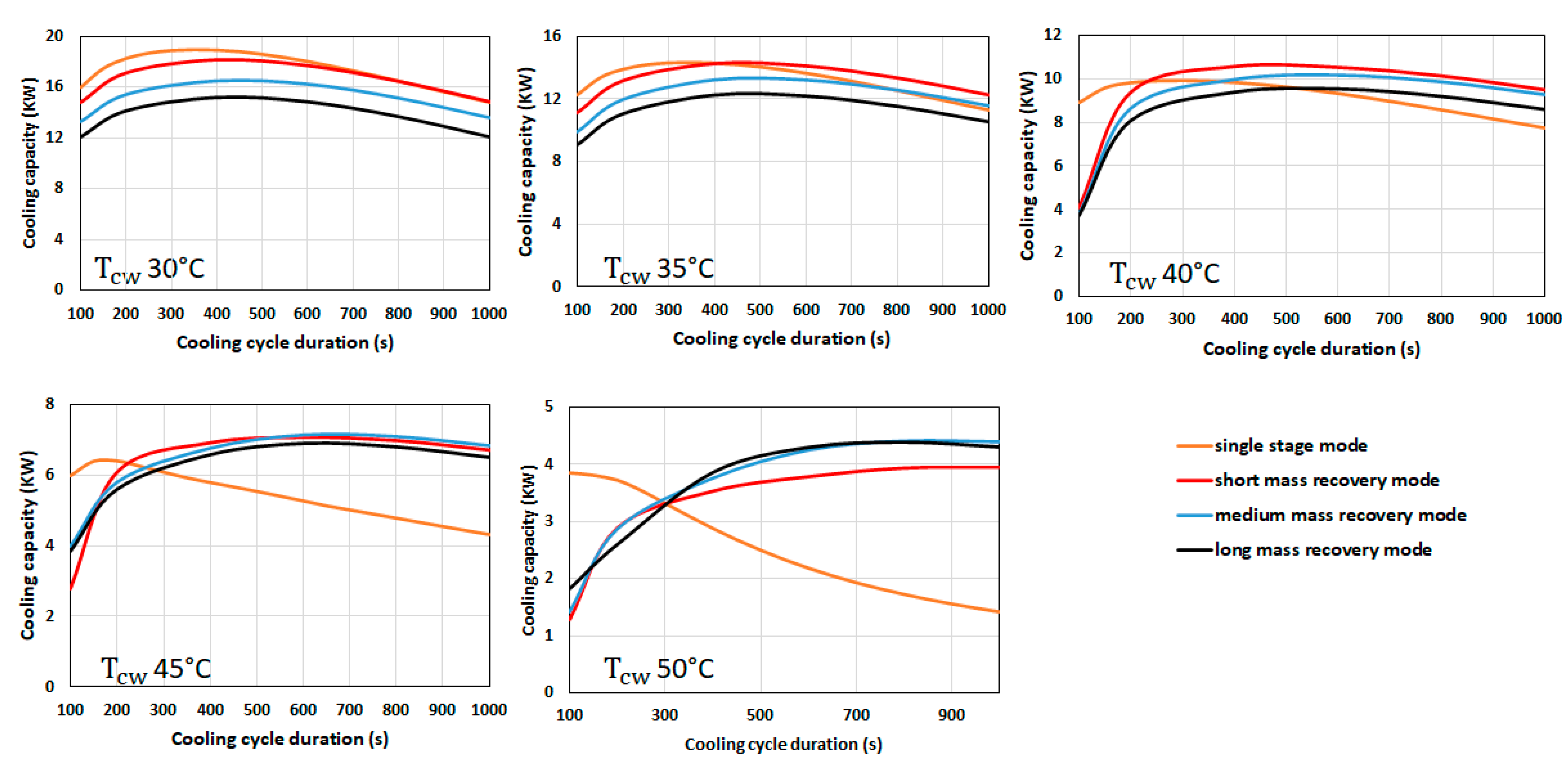



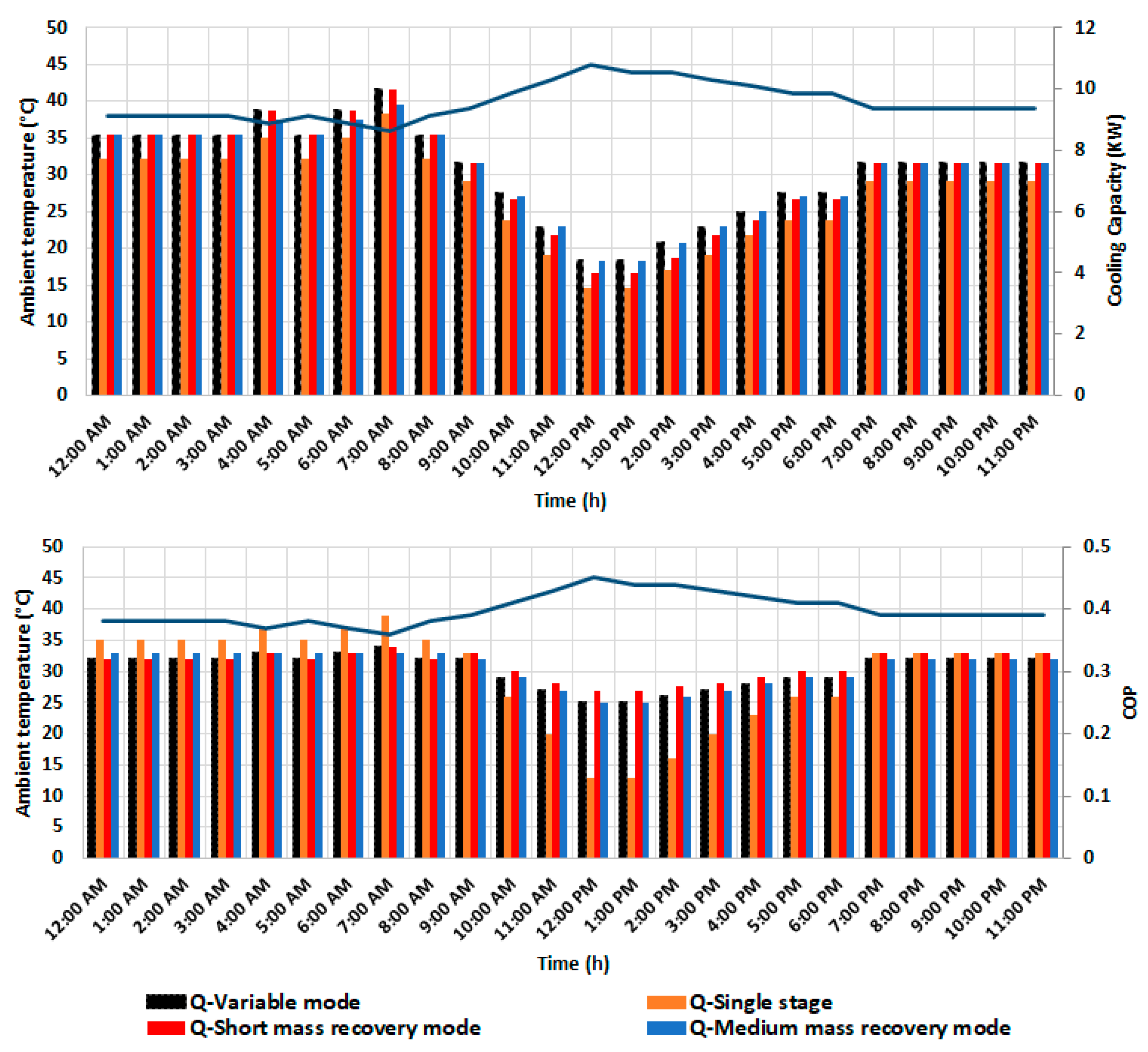

| Equilibrium Model | Equation | Parameters |
|---|---|---|
| Dubinin–Astakhov (D–A) | : uptake (kg·kg−1) : maximum uptake (kg·kg−1) : characteristic energy (kJ·mol−1) : heterogeneity parameter : universal gas constant (kJ·mol−1·K−1) : bed temperature (K) : equilibrium pressure (kPa) : saturated pressure (kPa) | |
| Freundlich | : uptake (kg·kg−1) : maximum uptake (kg·kg−1) : heterogeneity factor : equilibrium pressure (kPa) : saturated pressure (kPa) | |
| Hill | : uptake (kg·kg−1) : maximum uptake (kg·kg−1) : Hill cooperativity coefficient : Hill constant | |
| Sun and Chakraborty (S–C) | : uptake (kg·kg−1) : maximum uptake (kg·kg−1) : pre-exponential coefficient : heterogeneity factor : isosteric heat of adsorption at zero surface coverage (kJ·kg−1) : enthalpy of evaporation (kJ·kg−1) : universal gas constant (kJ·kg−1·K−1) : bed temperature (K) : equilibrium pressure (kPa) : saturated pressure (kPa) |
| Equilibrium Model | Parameters | |
|---|---|---|
| D–A | (kJ·mol−1) | (−) |
| 7.1067 | 3.943 | |
| Freundlich | (−) | |
| 5.9199 | ||
| Hill | (−) | (−) |
| 2.2337 | 0.0039 | |
| S–C | (−) | (−) |
| 2.71 × 10−6 | 2.2307 | |
| Temperature (°C) | Model | RMSE | R2 |
|---|---|---|---|
| 34 | Hill | 0.0066 | 0.9948 |
| D–A | 0.0072 | 0.9947 | |
| S–C | 0.0364 | 0.8533 | |
| Freundlich | 0.0751 | 0.9926 | |
| 40 | Hill | 0.0089 | 0.9936 |
| S–C | 0.0113 | 0.9959 | |
| D–A | 0.0124 | 0.9939 | |
| Freundlich | 0.038 | 0.8447 | |
| 70 | D–A | 0.0103 | 0.9848 |
| S–C | 0.0124 | 0.9817 | |
| Hill | 0.0126 | 0.9774 | |
| Freundlich | 0.0384 | 0.7954 |
| Parameter | Ea (J·mol−1) | Dso (m2·s−1) | RMSE | R2 |
|---|---|---|---|---|
| 0% < P/P0 < 5% | 2.06 × 104 | 3.95 × 10−9 | 0.0046 | 0.946 |
| 5% < P/P0 < 15% | 2.41 × 104 | 7.62 × 10−9 | 0.0066 | 0.978 |
| 15% < P/P0 | 2.974 × 104 | 2.444 × 10−8 | 0.0120 | 0.871 |
| Single Stage | Short Mass Recovery | Medium Mass Recovery | Long Mass Recovery | |||||||||
|---|---|---|---|---|---|---|---|---|---|---|---|---|
| Recooling Water Temperature (°C) | Optimum Cooling Cycle Time (s) | Qe (KW) | COP | OCCT (s) | Qe (KW) | COP | OCCT (s) | Qe (KW) | COP | OCCT (s) | Qe (KW) | COP |
| 30 | 350 | 18.9 | 0.48 | 450 | 18.2 | 0.41 | 450 | 16.5 | 0.36 | 450 | 15.2 | 0.34 |
| 35 | 350 | 14.4 | 0.46 | 500 | 14.4 | 0.39 | 500 | 13.4 | 0.35 | 500 | 12.4 | 0.33 |
| 40 | 300 | 9.9 | 0.41 | 500 | 10.7 | 0.35 | 600 | 10.2 | 0.34 | 600 | 9.5 | 0.33 |
| 45 | 200 | 6.4 | 0.29 | 600 | 7.1 | 0.31 | 650 | 7.2 | 0.30 | 650 | 6.5 | 0.29 |
| 50 | 100 | 3.5 | 0.13 | 900 | 3.9 | 0.27 | 800 | 4.4 | 0.25 | 800 | 4.4 | 0.25 |
Publisher’s Note: MDPI stays neutral with regard to jurisdictional claims in published maps and institutional affiliations. |
© 2021 by the authors. Licensee MDPI, Basel, Switzerland. This article is an open access article distributed under the terms and conditions of the Creative Commons Attribution (CC BY) license (https://creativecommons.org/licenses/by/4.0/).
Share and Cite
Alsarayreh, A.A.; Al-Maaitah, A.; Attarakih, M.; Bart, H.-J. Performance Analysis of Variable Mode Adsorption Chiller at Different Recooling Water Temperatures. Energies 2021, 14, 3871. https://doi.org/10.3390/en14133871
Alsarayreh AA, Al-Maaitah A, Attarakih M, Bart H-J. Performance Analysis of Variable Mode Adsorption Chiller at Different Recooling Water Temperatures. Energies. 2021; 14(13):3871. https://doi.org/10.3390/en14133871
Chicago/Turabian StyleAlsarayreh, Ahmad A., Ayman Al-Maaitah, Menwer Attarakih, and Hans-Jörg Bart. 2021. "Performance Analysis of Variable Mode Adsorption Chiller at Different Recooling Water Temperatures" Energies 14, no. 13: 3871. https://doi.org/10.3390/en14133871
APA StyleAlsarayreh, A. A., Al-Maaitah, A., Attarakih, M., & Bart, H.-J. (2021). Performance Analysis of Variable Mode Adsorption Chiller at Different Recooling Water Temperatures. Energies, 14(13), 3871. https://doi.org/10.3390/en14133871






